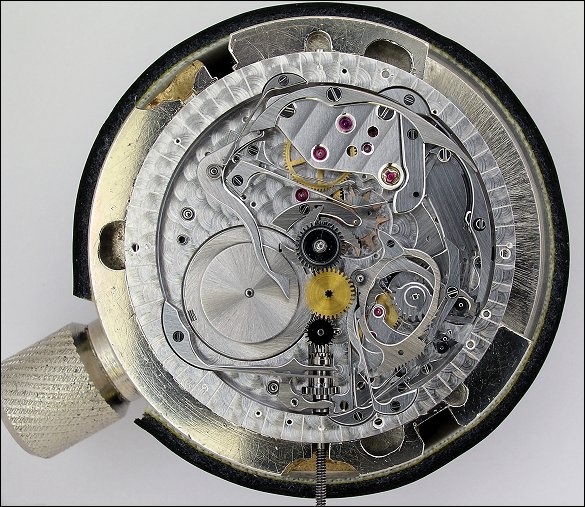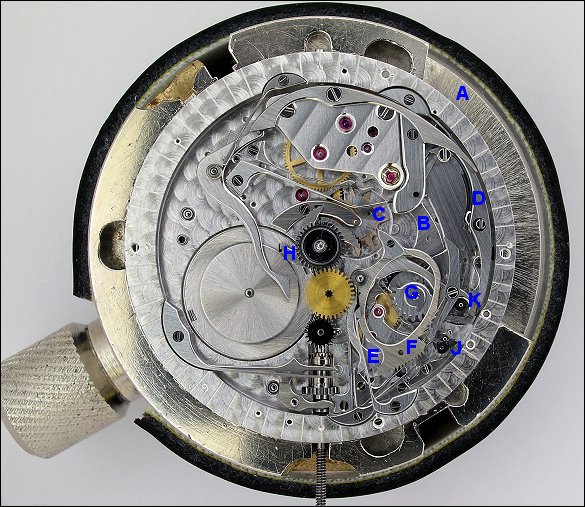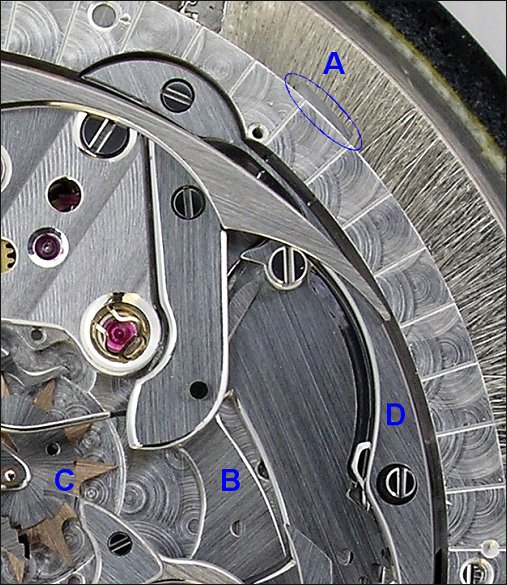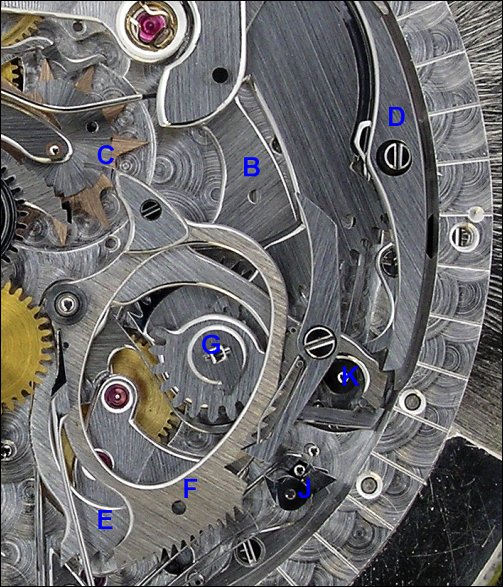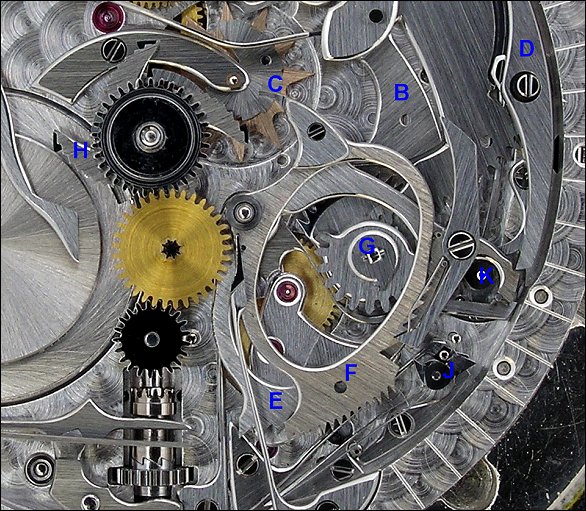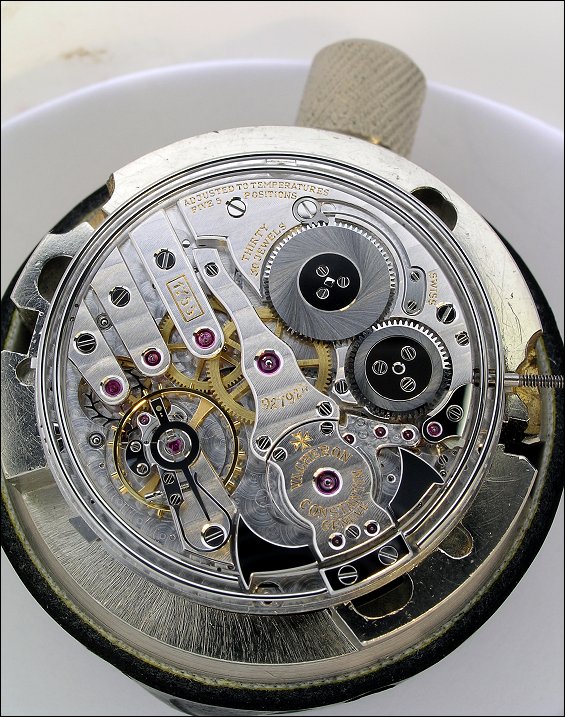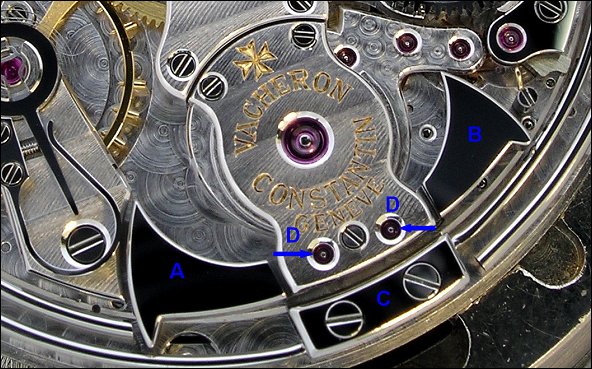|
A Minute Repeater Tutorial
by Ron DeCorte June, 2004
While visiting Vacheron Constantin in March, I was offered the opportunity to photograph some interesting watch movements in various states of completion, one of them being a minute repeater. Unlike a lot of other watch complications, the repeater is a bit mysterious, having most of its mechanism hidden under the dial. And so I thought it would be interesting to present an article on the subject of repeaters, particularly the minute repeater. This is not a definitive article on the subject, but rather a brief tutorial.
Striking watches, repeaters, were developed prior to electricity when checking the time during the night wasn’t as easy as turning on a light bulb or looking at the illuminated electric clock. And during some of those long Sunday church services many a man was known to reach into his pocket, cradle his repeater in his hand, and count the hours and minutes until he was free to go fishing, drinking with his buddies at the pub, or visit his mistress!
A Vacheron Constantin minute repeater wristwatch movement, topless. The minute repeater strikes the hours, quarter hours, and minutes, on two gongs, each with a different pitch. Yes, there are exceptions to this two-gong rule, but they are very rare.
Basic operational and striking components of a minute repeater (see detail below).
Setting the hour strike: The main operating lever “A” (inside the ellipse) slides along the perimeter of the watchcase and pushes the hour-foot “B” against the hour-snail “C” containing 12 steps (hence 12 hours). The hour-foot is shaped like a boot, it’s the toe of the boot (hidden) that contacts the hour-snail and sets the number of hours to be struck. The hour-snail is attached to a star wheel and is indexed once each hour.
Setting the quarter strike: When the main operating lever (slide) has been completely cocked and the hour-foot toe has contacted the hour-snail, the all-or-nothing spring “D” will release the quarter-rack “E” allowing it to rotate (fall) and make contact with the four step quarter-snail (hidden) that is located directly under the minute-snail. Note: The all-or-nothing spring gets its name for the fact that it only allows the watch to strike when the repeater mechanism has been fully cocked, eliminating false (incorrect) striking.
Setting the minute strike: When the all-or-nothing spring releases the quarter-rack it also releases the minute-rack “F” that will rotate (fall) against the minute-snail “H”. The minute-snail has four leaves, each with 14 steps (look closely, one leaf is hidden), and makes one revolution each hour. Notice the saw-toothed teeth on the edge of the minute and quarter racks (and similarly for the hours, hidden). These teeth will pass by the hammer-trips “J” and “K” when the racks fall and then engage the trips as the racks are retracted during the strike sequence, causing the hammers to strike the gongs.
Lets examine the process so far: The main operating lever (slide) is cocked, pushing the hour-foot toe against the hour-snail, the all-or-nothing spring releases the quarter-rack and minute-rack allowing them to fall onto their respective snails. At this point the mechanism is “cocked” and ready to strike the hour(s), quarter hour(s), and minute(s). Note: cocking the main operating lever also winds the strike-spring, a small main spring located at “G” (hidden) that will provide the power to raise the racks and make the striking.
A view of the Vacheron Constantin minute repeater movement from the back.
As mentioned earlier the hammers “A” and “B” will strike the gongs “C” to mark the hours, quarter-hours, and minutes accordingly. Hammer “A” is the “hour-hammer” and “B” is the “minute-hammer”. The hour and minute hammers are used in alternating sequence to mark the quarter hours. Note that the hour-gong has a slightly lower tone (dong) than the minute-gong (ding), hence it is slightly longer and tuned differently.
Note: “Jeweled-To-The-Hammers” is a common statement when referring to high-grade repeater watches. Notice that the above Vacheron Constantin watch has two hammer-jewels “D” and the entire strike train is also jeweled, on both sides, making for a more friction and wear resistant watch. In some cases there is little, or no, jewelling of the strike train and in certain cases only jewels on the (visible) back side of the watch creating an illusion of quality that might not exist.
OK, lets make some noise, or music as the case may be. Lets say it’s 03:35, and the slide has been cocked and released. The third hour will be marked by three strikes on the hour-gong (dong-dong-dong), the second quarter of the hour is marked on the minute and hour gongs (ding-dong/ding dong), and the minutes are marked on the minute-gong (ding-ding-ding-ding-ding).
Sounds simple doesn’t it? But believe me a striking watch requires a lot of precision to fu8nction properly and this article is only the tip of the ice-berg!
Some important notes and comments about repeating/striking watches:
· Early repeating watches, “quarter repeaters”, marked the hours and quarter-hour. Later the “half quarter repeater” was developed to mark the hour, quarter hour, and half-quarter hour. The “five-minute” repeater marks the hour and indicates the minutes within five. And then of course the minute repeater.
· A minute repeater is extremely complicated, far more complex than a tourbillon or perpetual calendar complication, surpassed in complexity only by the “grand-petit-sonnerie-minute-repeater” complication.
· All repeating/striking watches demand the most careful attention in operation and servicing.
· It’s imperative that striking watches be serviced by highly qualified technicians. Each and every, and I mean EVERY, component should be removed and cleaned by hand. Anything less will result in corrosion and/or a sticky mess that will not operate correctly. You wouldn’t take your expensive automobile to a back-yard mechanic would you?
· Never force the strike operation or setting of the hands. Stop and get professional help.
· Moisture is the death of complicated watches. If you have complicated watches in storage, make sure they are stored in a dry wooden box (cigar boxes work very well), wrapped in a piece of wool (or a wool sock).
If you would you like to see a more technical article regarding minute repeaters let us know, it might be arranged!
Please click here to return to TimeZone's Vacheron Constantin Forum to leave comments about this article.
© Copyright Ron DeCorte 2004 All rights reserved
|
